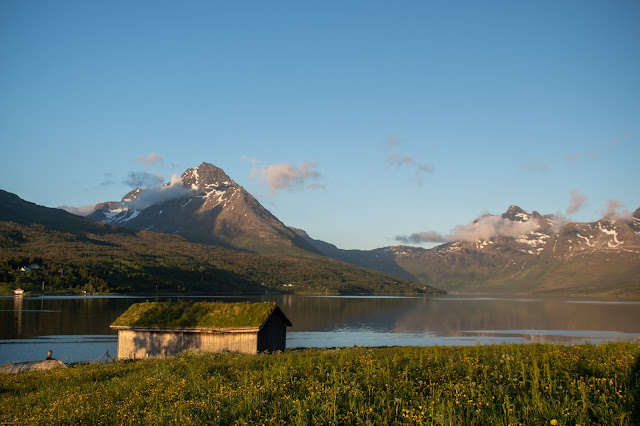June 9th - 21st Lødingen - Harstad (and Sørumsand)
Tjeldsundet separate the Lofoten and Vesterålen Island Chains from the mainland and had to be my route for continuing north. The Lofoten Island Chain makes a barrier for the tidal wave going up along the Norwegian coast. There are more water "wanting" to go through the 25 nautical mile long narrows, from Ofotfjorden in the south to Vågsfjorden in the north, than actually is able to. Thus the tidal range on the north side of Tjeldsundet is around 75 % og the range on the south and there are significant speed on the current. Thus I har to find how the current runs compared to the tides and study the tidal charts.
I found that I had to leave Lødingen at noon to get the current with me the entire trip through. Consequently I ended my work day short, I actually had to re schedule a meeting. Since Tjeldsundet makes for more protected waters than much of the rest of costal Northern Norway whilst retaining the mild winters it is rather much for the latitude on land.
On a smal peninsula out into the narrows lie the old trading post Sandtorgholmen. This is one of the oldest trading posts in Norway with the first written record from 1321 AD. The oldest building on the site is an earth cellar from around 1550. Today the trading post is run as a hotel and from the sea it looks really idyllic.

As I left Tjeldsundet the wind really picked up and I started to worry about docking. In the end and with som help I managed to docking the downtown guest harbour ok. The lady who helped me informed me that there where visitors mooring in their boat club just south of the city that weren't as rolly as, so I moved there. And in the end the boat was docked there for almost two weeks. Beside waiting out weather I received a text message from the municipality at home about scheduling Corona vaccine. So I jumped on a plane and flew down south (actually I walked, took a bus, a plan, a train and another train and walked some more to get home). I stayed at home for five days before flying back ready to continue my journey.

Harstad has long ship building traditions, the original Rulten was built here in 1907. Now active shipbuilder is left in the city itself. However there are several "monuments" of the shipbuilding past all around the city. On Rødskjær just north of Sandtorgholmen inside the municipality but quite a bit outside the city Selfa Arctic is building glassfibre fishing boats of the in Norway very common size between 10 and 15 m. Selfa Arctic build the first electric fishing boat in 2015 and today they offer an electric drivetrain in all their models.
Several of the slipways and dry-docks of the former shipbuilders are in use today maintaining ships. An oddball in this context is this former Norwegian Navy frigate Bergen. According to wikipedia she was sunk as an objet for training with submarines in 2007. Clearly she is not sunk, even if she in the dry-dock technically might be on the bottom of the sea.















































